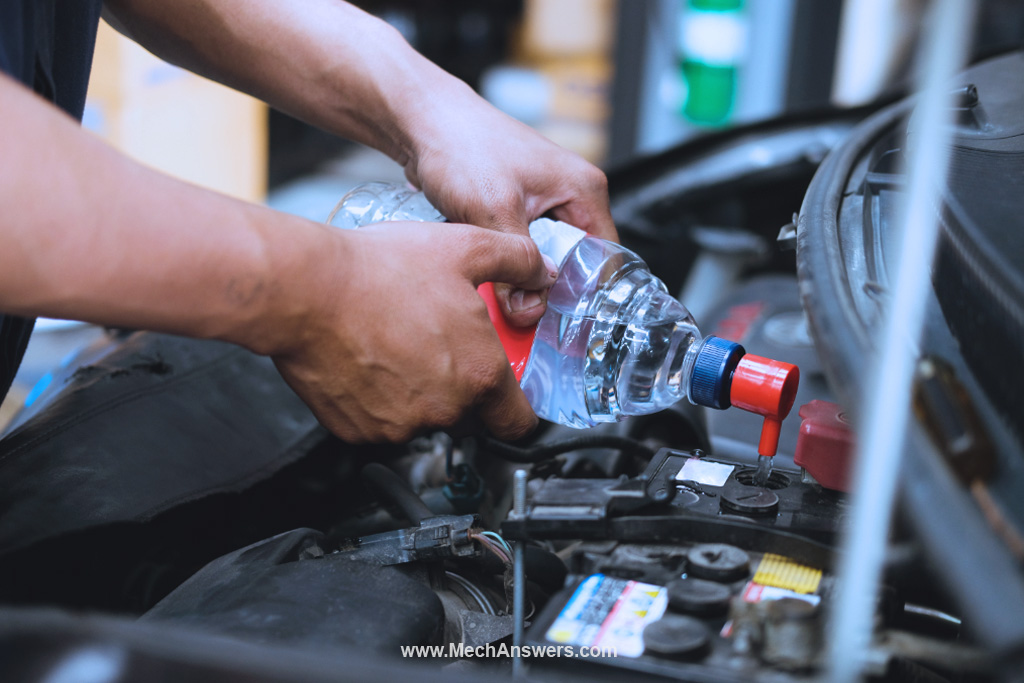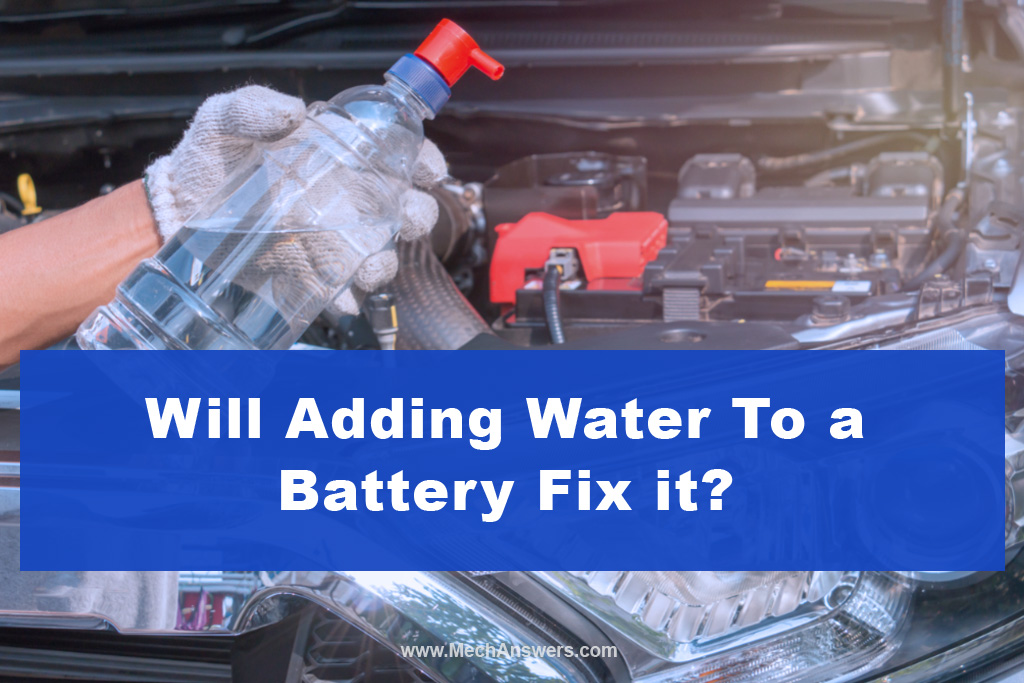You may ask yourself, perhaps even searching for “Will Adding Water To A Battery Fix It?”, haven’t you? Well, search no more. This article will help you understand the nuances of car battery maintenance, specifically focusing on the implications of adding water to a battery.
So, will adding water to a battery fix it? Indeed, in some circumstances, adding distilled water to a battery can restore its performance. This is usually the case when the battery water level has dropped below the recommended limit due to evaporation or minor leaks.
Reading this article will equip you with critical knowledge about maintaining your car battery’s longevity. You will learn how, when, and why to add water to a battery, helping you avoid unnecessary battery replacement costs and ensuring a smoother drive.
Table of Contents
Which Batteries Contain Water?
Generally, when you think of batteries you don’t think about water. Or if you do you think about how the two don’t mix. The exception to this rule is called a lead-acid battery. Though in the context of watering batteries, it is important to specify we’re talking about flooded lead-acid batteries.
These batteries contain an electrolyte mix of water and sulfuric acid that is essential for the operation of the battery. This mix is free to flow throughout the battery. Other lead-acid batteries contain an electrolyte mix but do not require watering.
- Lead-acid wet cell
- Absorbent glass mat
- Lead-acid gel cell
Absorbent glass mat (AGM) batteries have a similar electrolyte but it is sealed within the glass mats the battery is named after. There is no water loss which makes an AGM battery maintenance-free.
The third main type of lead-acid battery is called a gel lead-acid battery. In this battery, the electrolyte has been modified to be a gel. Like AGM batteries, these are sealed so that there is no water loss.
So while all lead-acid batteries contain water in some form, only flooded lead-acid batteries need watering.
Why Does Adding Water Fix Lead-Acid Batteries?
Can You Add Water To a Battery To Fix It?
The direct answer to this question is yes, in certain circumstances, adding water to a battery can indeed fix it. This is particularly the case with lead-acid batteries, including the ones commonly used in most vehicles.
These batteries contain a mixture of sulfuric acid and water, which forms an electrolyte solution critical for the battery’s operation. When this electrolyte level falls below the recommended level, often due to evaporation or the gassing process, it disrupts the battery’s ability to function effectively.
What Kind of Water Should You Use?
Over time, lead-acid batteries lose water due to evaporation and electrolysis, especially when exposed to high temperatures or if the battery is frequently overcharged.
In such cases, replenishing the lost water can restore the battery’s functionality and extend its life. However, it’s not as simple as pouring tap water into the battery. To prevent introducing impurities or minerals that could interfere with the battery’s chemical reactions, only distilled or deionized water should be used.
Using the wrong kind of water can lead to build-up on the lead plates inside the battery, reducing its performance and possibly leading to failure.
How Should You Add Water to the Battery?
Adding water to the battery should be done carefully to avoid overfilling. The water level should ideally be just enough to cover the plates.
If the battery is filled too high, it can result in electrolyte leakage during charging, which can cause damage and corrosion.
It’s also important to note that water should be added to the battery only after it has been fully charged unless the plates are exposed.
Charging a battery causes the water inside to expand, and if the battery has been filled to the maximum before charging, it can overflow, leading to acid spills.
What Problems Can Adding Water Solve?
While adding water can temporarily fix a battery with low electrolyte levels, it’s not a remedy for all battery problems.
If the battery’s issues stem from worn-out lead plates, a short circuit within the battery, or other internal damage, adding water will not solve the problem. In such cases, the only solution may be a complete battery replacement.
Why Would a Battery Need Water Added Regularly?
Furthermore, constantly having to add water to a battery is an indication of an underlying issue, such as overcharging or operating in an overly hot environment. These issues need to be addressed to prevent recurring water loss and potential battery failure.
Conclusion: Should You Add Water to Your Battery?
In conclusion, while adding distilled water to a battery can fix it in some circumstances, it should be viewed as a part of regular maintenance rather than a cure-all solution.
If a battery consistently loses water or exhibits performance issues, it’s essential to have it checked by a professional to diagnose and rectify the root cause of the problem.
When Should You Add Water To a Battery?
Adding water to a battery is not something that should be done randomly or arbitrarily. Instead, there are specific conditions and times when this process is necessary and can prove beneficial. So when exactly should you add water to a battery? Let’s discuss this.
Regular Maintenance Checks
The most common occasion to add water to a battery is during regular maintenance checks. For lead-acid batteries, these checks are generally recommended every 2-3 months, although the frequency may vary depending on the vehicle’s usage and the battery type.
During these maintenance checks, the battery’s electrolyte level is inspected, and if it is found to be low, distilled water is added.
Prior to Charging
Another crucial time to check the water level in your battery is before charging it. If you notice that the electrolyte level is low, but the plates are still submerged, you should add water after the battery has been fully charged.
However, if the plates are exposed before charging, you should add just enough water to cover them, then add more after the battery has been charged.
Remember, charging a battery causes the electrolyte to expand, and overfilling it can cause acid to leak out, damaging the battery and surrounding areas.
When You Notice Performance Issues
If you notice performance issues with your vehicle, such as slow engine cranking, or flickering lights, or if your battery seems to run out of charge quickly, it may be time to check the battery’s water level.
These problems can sometimes be attributed to a low electrolyte level, and adding water may improve battery performance.
Hot Weather Conditions
Hot weather can cause the water in the battery to evaporate faster than usual, leading to a lower electrolyte level.
If you’re in an area experiencing a heatwave, or if you live in a place with a generally hot climate, you may need to check your battery’s water level more frequently.
Adding water during these conditions can help to maintain the battery’s function and lifespan.
In conclusion, while adding water to your battery can often be helpful, it’s crucial not to overfill it and only to use distilled or deionized water.
Always remember to handle batteries carefully, as they contain sulfuric acid, which is highly corrosive and can be dangerous if it comes into contact with your skin or eyes.

A Step-by-Step Guide On How To Add Water To a Lead-Acid Battery
Knowing how to properly add water to a lead-acid battery is essential for any vehicle owner. Incorrectly doing this procedure can result in damage to the battery or, in severe cases, personal injury. Follow this step-by-step guide to do it correctly and safely.
Step 1: Gather Your Materials
First, you will need distilled water, a screwdriver or wrench (depending on your battery’s design), and protective gear like gloves and goggles. Always use distilled water when adding water to a battery, as tap water contains minerals and impurities that can harm the battery’s performance.
Step 2: Unplug The Battery
Before starting, ensure that the vehicle is off and that the battery is disconnected. You will generally need to disconnect the negative terminal first, then the positive. It’s crucial to disconnect the battery before proceeding to prevent any electrical accidents or short circuits.
Step 3: Remove The Cell Caps
Next, use your screwdriver or wrench to remove the cell caps from the top of the battery. These caps are usually screwed on, but some models may just pop off. Make sure to place these caps in a safe place where they won’t get lost or damaged.
Step 4: Check The Electrolyte Level
Check the electrolyte level in each cell. It should be just above the top of the battery plates. If it’s below this level, you’ll need to add water. Remember that overfilling the cells can cause the battery to leak acid, which is hazardous.
Step 5: Add Distilled Water
Slowly add distilled water to each cell until the electrolyte level is just above the battery plates. It’s crucial to add the water slowly to prevent overfilling. Only fill to the designated fill line or just above the plates, depending on your battery’s design.
Step 6: Replace The Cell Caps
After filling the cells, replace the caps securely. Ensure they’re screwed or popped back on tightly to prevent leakage. A securely replaced cell cap ensures the battery’s internal components are protected.
Step 7: Reconnect The Battery
Lastly, reconnect the battery, attaching the positive terminal first, followed by the negative. Properly reconnecting the battery ensures the vehicle’s electrical systems function correctly.
Step 8: Charge The Battery (If Needed)
After adding water, you may need to charge the battery. Consult your vehicle’s manual or speak with a professional if you’re unsure. A fully charged battery ensures optimal performance.
Follow these steps carefully, and remember to regularly check your battery’s water level as part of your vehicle maintenance routine. Regular maintenance helps extend the battery’s life and ensures reliable vehicle operation.
How To Add Water to a Car Battery That Requires Maintenance >> Check out the video below:
Related Articles
Read more >> Why Do I Have To Jump My Car Every Time I Turn It Off?
Read more >> Is It Bad To Jumpstart A Car Everyday? (Your Safety Guide!)
Read more >> What Happens If You Connect Battery Terminals Together?
Read more >> What Happens If Car Battery Is Low On Water?
Conclusion
Whether your battery needs watering or not, ensure you know the best way to take care of it for peak performance. If your battery does need watering make sure to check it routinely. Always use the correct water and don’t add too much.
As long as you exercise caution while adding water to your battery this is something you can do yourself. That said, your local mechanic will be able to perform this service if you would prefer.
Reference Source:
batteryclerk.com/pages/types-of-lead-acid-batteries

